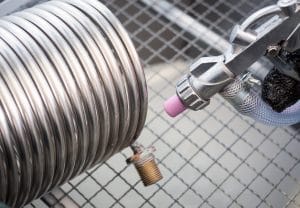 Electrical thermal management is a vital part of most companies’ operations. As such, the efficiency of a company’s electrical cooling systems plays a major role in its overall efficiency and productivity. Because of its importance, thermal management has also been a key focus of advancement for most modern technologies. For example, once it became obvious that traditional solutions, such as air conditioners, were too cumbersome and energy draining to be utilized for more advanced applications, companies began turning more frequently to heat exchangers. Rather than cooling electrical enclosures with chilled air, heat exchangers approach thermal management with the philosophy of transferring heat, which is a much more manageable and easily adaptable process.
Electrical thermal management is a vital part of most companies’ operations. As such, the efficiency of a company’s electrical cooling systems plays a major role in its overall efficiency and productivity. Because of its importance, thermal management has also been a key focus of advancement for most modern technologies. For example, once it became obvious that traditional solutions, such as air conditioners, were too cumbersome and energy draining to be utilized for more advanced applications, companies began turning more frequently to heat exchangers. Rather than cooling electrical enclosures with chilled air, heat exchangers approach thermal management with the philosophy of transferring heat, which is a much more manageable and easily adaptable process.
The secret to eco-friendly heat transfer
The secret to how heat exchangers make thermal management more efficient lies in the natural methods they utilize to transfer electrical waste heat. Heat exchangers contain an eco-friendly cooling fluid, like water, that constantly absorbs waste heat as soon as it’s emitted. After absorbing enough heat, the fluid flows to a heat sink or other heat dissipation unit, where it can safely release the heat and flow back to continue transferring more. Because transferring heat doesn’t need the same complicated equipment as traditional cooling solutions, they also don’t need as much energy to operate, and they can be adapted to meet most application’s electrical cooling needs.
The benefits of modern heat exchangers
- No need for clunky equipment – Using simplified heat transfer methods instead of traditional cooling processes means heat exchangers are typically smaller, and don’t need to be maintained as often. Fewer external moving parts means heat exchangers are less likely to break down or malfunction, which means companies reduce their risks of downtime and loss of productivity and revenue associated with it.
- Lower reliance on energy – The fact that heat exchangers utilize a fraction of the energy to transfer heat than air conditioners use to chill air means that they can operate 24/7 without costing companies a small fortune in energy usage. In addition to boosting productivity, this means transferring heat also helps companies save significantly in energy costs.
- Easier adaptability and customization – Technology has advanced more rapidly than ever over the last few decades, and the ability to implement customized, high-performance thermal management solutions into new, innovative applications has been an important catalyst. Transferring high amounts of waste heat is efficient and streamlined enough that heat exchangers can be created in a wide variety of styles. Using the design that’s most appropriate, companies can enjoy the most efficient thermal management solutions for each of their applications.
For more information about the efficiency of transferring heat compared to cooling it, call Noren Thermal Solutions in Taylor, TX, at 866-936-6736.







